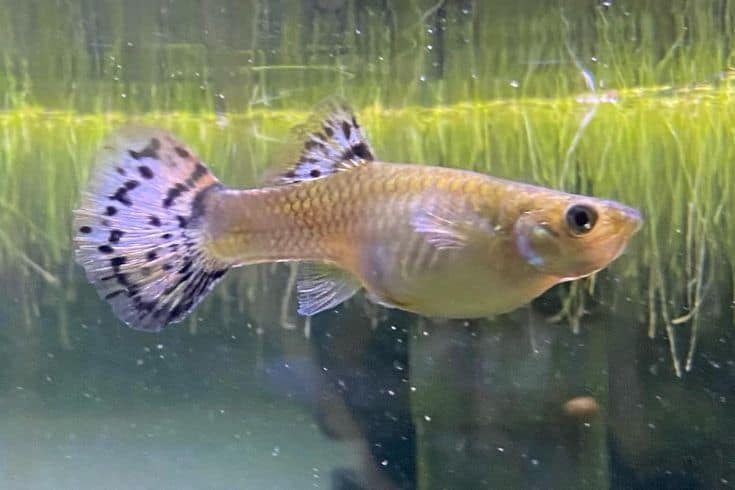Think about a tropical fish – what comes to mind? Chances are, you’re picturing some sort of guppy! Guppies are one of the most popular aquarium inhabitant species in the world and for a good reason. These brilliant little fish come in many different colors and sizes, making them incredibly versatile additions to any tank.
But these fish aren’t just beautiful – they possess some truly fascinating characteristics that make them unique. From their unique methods of reproduction to their natural habitat preferences, here are some interesting guppy facts that you may not have known!
15 Amazing Facts About Guppies
1. They were named after the man who discovered them

Guppies have been around for a long time, but it wasn’t until the 19th century that they were first discovered by Robert John Lechmere Guppy. Though Wilhelm Peters discovered it a few years prior, guppy was the man who sent specimens of the fish to England, and thus, they were named Girardinus guppii in his honor.
In the years since, the name Poecilia reticulata has been used as the scientific name for the species, but many people still refer to them as Guppies. And who could blame them? It’s a fitting name for such a unique and colorful fish!
2. They are found in the wild in tropical climates
Guppies are tropical fish native to South America, and are found in slow-moving freshwater streams and ponds. These fish favor tropical climates, which means that temperatures in their natural environment tend to remain fairly consistent throughout the year. In addition, they enjoy living in areas with plenty of hiding spots, such as plants and rocks.
Because of their natural habitat preferences, guppies are not well-suited to colder temperatures and will usually fall sick or die in water temperatures below 68 degrees Fahrenheit. We recommend investing in a reliable heater and a good thermometer – these tools will make sure that your water is kept at a warm, constant temperature.
3. They are also known as millions fish

It may seem a little far-fetched to call such a small fish “millions,” but that is exactly what guppies are known as. This nickname comes from their tendency to breed quickly and in large numbers. A single female guppy can produce up to 1000 fry (baby fish) over the course of a year, making guppies some of the fastest-breeding fish in the world.
This ability to reproduce numerous offspring rapidly is a unique trait, but make sure your tank doesn’t get overcrowded! Keep an eye on your tank’s population and remove any fry if needed.
4. Males are more colorful than females
One of the easiest ways to tell a male guppy apart from a female is by looking at their colors. Male guppies tend to be more brightly colored and showier than their female counterparts, which is thought to be a mechanism for attracting mates. In contrast, females are usually plainer and duller in color, with a gravid spot that darkens when she is ready to release fry.
Being able to tell males and females apart is essential because you want to maintain a ratio of 1 male to 3-4 females in the tank to avoid any aggressive behavior. If you notice males consistently harassing one of the females, it’s time to add more females or remove some of the males. You don’t want your female fish getting stressed out!
5. They give birth to live young

Guppies don’t have a breeding season, per se, but they do reproduce throughout the year. When the female guppy is ready to give birth, she will release anywhere from 20-100 fry (baby guppies) into the water. The fact that guppies give birth to fully formed young instead of eggs makes them livebearers, which is quite different from most other species of fish.
What’s more, the fry are already able to swim and feed themselves immediately after birth, making guppies relatively easy to care for even as young fish. They also mature quickly. At just 8 weeks of age, guppies are usually ready to reproduce themselves, making their lifecycles extremely fast. You’ll watch your tiny guppy fry grow up in just a blink of an eye!
6. Guppy parents eat their young
Despite the fact that guppies give birth to live young, there is still a risk that the fry will become food for their own parents. This is because adult guppies are omnivorous in the wild and will eat anything they can find, including their own offspring.
To prevent this from happening, it is important to provide the fry with plenty of hiding spots. Aquarists can do this by adding plants and rocks to the aquarium, or using a breeding trap that isolates the fry from their parents. Doing this will give them ample opportunity to hide and grow big enough to compete for food.
7. They were used to fight malaria in India
Did you know that guppies were used to combat the spread of malaria in India? This is because guppies are natural predators of the mosquito larvae that carry the malaria parasite. The average guppy finds mosquito larvae in natural water sources to be quite appetizing, leading to a decrease in the number of carriers of malaria.
8. Guppies make good algae eaters
People rarely think of guppies as algae-busting aquarium superheroes, but these little fish actually work quite well as natural cleaners. These omnivores are usually content to feast on plant particles they encounter in the aquarium, but they will also munch on algae if given the chance.
So, if you have a tank overrun with algae, you might consider adding some guppies to the mix. Just don’t expect a miracle overnight—it may take a few weeks for the guppies to get a handle on things. But, in general, these little fish make excellent additions to any tank and will help keep things looking neat and tidy.
9. They were used to test drinking water

This one raises some ethical concerns, but it doesn’t change the fact that guppies were once used to test the safety of drinking water. In some parts of the world, it is fairly common to place guppies into bodies of water and then measure the mortality rate. If the guppies die off quickly, it is likely that the water is contaminated and should not be used for drinking.
Of course, this isn’t the most humane or reliable method of testing for water contamination. However, scientific tools and test strips aren’t necessarily available to everyone, so this is still a method that is used in some parts of the world.
10. Guppies thrive in schools
At first glance, guppies may seem like solitary creatures, but they actually thrive in groups. In the wild, guppies form schools of up to a thousand individuals and often share territory with other fish species. The same holds true in captivity, as guppies become much more active and social when they are kept in groups of four or more.
This behavior is also thought to reduce stress levels in the fish. Being part of a school helps guppies feel safe and secure, reducing the risk of territorial disputes and other forms of aggression. So, if you’re thinking about adding guppies to your aquarium, make sure you get enough to form a school!
11. Healthy guppies can survive without food for two weeks

Letting your guppies go without food is not something we recommend, but it is interesting to note that healthy guppies can survive for up to two weeks without food. Healthy adult guppies have the remarkable ability to store energy in their bodies, allowing them to go without a meal for quite some time.
The specific period of time will depend on the individual fish and its current health. However, we do not recommend testing this theory—your guppies should always have a regular food supply to ensure they are getting the nutrition they need. Even a brief period of starvation can have a negative impact on their health, so be sure to stick to a regular feeding schedule.
12. Most aquarium guppy fish are selectively bred
Don’t get us wrong, guppies are beautiful fish even in their natural state. However, most of the guppies you’ll find at pet stores have undergone generations of selective breeding. This produces the wide range of colors and tail shapes that you see in aquariums today. It is also why so many different types of guppies are available.
The practice of selectively breeding guppies is known as “fancying” and has been around for more than a hundred years. While it is a fascinating process, it can also be controversial. Some argue that selectively bred guppies may not be as hearty or as healthy as their wild counterparts. So keep this in mind if you ever decide to start a fancy guppy tank!
13. Female guppies can store sperm in their bodies

Guppies are famous for their prolific breeding habits, but did you know that female guppies can store sperm in their bodies? This allows them to have up to eight pregnancies from just one insemination. In other words, female guppies don’t need to undergo the mating process repeatedly to get pregnant – they’ll just use the sperm they already have stored up.
Evolutionarily speaking, this process is particularly useful for guppies because it allows them to reproduce even when potential mates are scarce. These fish are vulnerable and rely on mass procreation to keep their species alive. So, storing sperm for future use is just one of the many ways guppies have adapted to survive in their environment.
14. Guppies get along with most types of fish
As one of the friendliest, most peaceful fish species, guppies are a popular choice for community aquariums. They don’t cause any trouble and they get along with most types of fish, from small tetras to bettas. Yes – even the notoriously aggressive betta can co-exist peacefully with guppies!
But don’t take our word for it. Always research any potential tank mates before you add them, and make sure they won’t be competing for the same food or space. You should also account for individual differences in personality. For instance, most bettas will leave guppies alone, but placing a nippy guppy and a territorial betta together can be asking for trouble.
15. The average lifespan of a guppy is around two years
After all that, two years might not seem like a long time. But for guppies, it’s actually quite a good run! You can extend the life expectancy of your guppy by taking proper care of their tank, feeding them a high-quality diet, and providing plenty of space to swim. However, even the best care won’t make your guppy immortal, and 2 to 3 years is the average life span.
Guppies are amazing creatures and it can be heartbreaking to lose one of your beloved fish. But don’t let this discourage you from owning guppies – they are some of the most rewarding and low-maintenance aquarium fish out there. With good care and dedication, you can enjoy their company for years to come.
The Takeaway
We hope these fun facts have given you a better understanding of guppies. With their bright colors, playful personalities, and impressive evolutionary adaptations, these fish are a delight to watch in any aquarium. Plus, guppies require minimal maintenance and can co-exist with many other types of fish. Overall, they make great pets for any level of aquarist!
Did you enjoy this article? Do you know someone who loves guppies? Please share this article with them! Every time you share, you help us spread our message and support the aquarium hobby. Thanks for reading!
